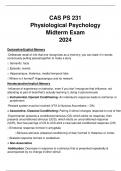CAS PS 231
Physiological Psychology
Midterm Exam
2024
Declarative/Explicit Memory
-Deliberate recall of info that one recognizes as a memory; you can state it in words;
consciously putting pieces together to make a story
1. Semantic: facts
2. Episodic: events
□ Hippocampus, thalamus, medial temporal lobe
Where is it formed? Hippocampus and its network
Nondeclarative/Implicit Memory
-Influence of experience on behavior, even if you don’t recognize that influence; not
attending to part of brain that’s actually learning it, doing it autonomously
1. Instrumental, Operant Conditioning: An individual’s response leads to reinforcer or
punishment
-Reward system must be involved (VTA & Nucleus Accumbens – DA)
2. Associative, Classical Conditioning: Pairing 2 stimuli changes response to one of them
-Experimenter presents a conditioned stimulus (CS) which elicits no response, then
presents unconditioned stimulus (UCS), which elicits an unconditioned response
(UCR), then few pairings of CS & UCS elicit a new, learned conditioned response (CR)
Emotional response formed in amygdala
Stimulus-stimulus (classical conditioning of fear) formed in thalamus or cortex
Skeletal response formed in cerebellum
3. Non-Associative
-Habituation: Decrease in response to a stimulus that is presented repeatedly &
accompanied by no change in other stimuli
,-Sensitization: Increase in response to a mild stimuli as a result of exposure to more
intense stimuli
Where are they formed? Spinal cord
4. Procedural Memory: The development of motor skills and habits
Where is it formed? Striatum
-Associated w/basal ganglia, motor cortex, cerebellum
5. Priming: Exposure to one stimulus influences the response to another stimulus.
-Priming works best when the two stimuli are in the same modality. For example visual
priming works best with visual cues
-Visual priming occurs in unimodal visual association cortex
-Neocortex: location of priming
Perceptual learning (vision): Unusual because completely unconscious – every time
you look at something, even if you don’t think about looking at it, changes your brain
Where is it formed? inferotemporal cortex
Multiple Trace Hypothesis: Each time some information is presented to a person, it
is neurally encoded in a unique memory trace composed of a combination of its
attributes – a memory consolidation model
Memory Stages
Incoming sensory information 1. Sensory buffer (200 ms) encoding 2. Short-
term memory, then u start giving it shape - working memory consolidation 3.
Intermediate-term memory 4. Long-term memory
-If short term memory not consolidated into long term memory, then lost forever
Anterograde amnesia: inability to form new (episodic) memories For events that
happened after brain damage
Retrograde amnesia: Poor access to old memories. But some very old memories are
accessible while more recent ones may not be Loss of memory for events that
occurred before brain damage
,Anatomical Manipulation Methods
Excitotoxic lesion: Destroy/inactivate specific brain region
-Destroys only cell bodies, spares axons passing through the region
Limitations Human lesions not specific, animal brains not all same, damage to
surrounding areas during surgery
Uses stereotaxic surgery
Freezing/Anesthetic Studies: Temporarily inactivates
specific brain region Uses stereotaxic surgery
HISTOLOGY
Staining: allows fine details of the brain to become visible so you can locate lesion
-Perfuse brain, fix brain, slice brain, stain brain Location of lesion
Anterograde tracing: labels the axons and terminal buttons leaving a
particular region Efferent, outgoing, motor axons
Where do neurons project to?
Retrograde tracing: labels cell bodies that give rise to the terminal buttons that form a
synapse with cells in a particular region
Afferent, incoming, sensory
axons Which areas are
projecting to these cells?
Computerized Axial Tomography (CT/CAT Scan): Uses x-rays, help detect
tumors/abnormalities
Magnetic Resonance Imagining (MRI Scanner): Find location of lesion in living
human brain; measures the magnetic spin of hydrogen ions
A magnetic field causes hydrogen atoms to align in the same orientation. A brief radio
frequency wave causes them to tile. When the radio frequency wave passes through
the head, atomic nuclei emit electromagnetic energy. By measuring this energy, MRI
scanner creates “slice” images of the brain and permits multiple views of the brain.
Shows anatomy smaller than mm in diameter
Diffusion Tensor Imaging (DTI): Find location of fiber bundles in living human brain;
measures neural tracts/white matter
An MRI technique that measures the degree of restriction of diffusion of water in
, tissue; Uses info about the movement of water molecules to determine the location
and orientation of bundles of axons in white matter
In DTI, there are two measures for each MRI voxel – rate of diffusion and preferred
direction of diffusion Tractography is 3d modelling of DTI data; DTI – Commissural and
association tracts
Recording Neuronal Activity
ELECTTROENCEPHALOGRAPHY – uses EEG to record electrical activity of the
brain using electrodes Can record spontaneous brain activity or evoked
responses/potentials (activity in response to a stimulus) Microelectrodes: Measure
post-synaptic potentials in a single neuron; small enough to pick up voltages
Macroelectrodes: Measure post-synaptic potentials across a population of cells;
receive signals from brainstem all the way up to the cortex
Multi-Unit array: Sits on top of brain to record activity, inside head
Positron Emitting Topography (PET Scan): Measures neurochemical in living brain
You get a glucose injection, which has radioactive atoms, which release positrons,
which interact with electrons, then they produce photons/gamma rays. Computer
determines how much photons/gamma rays in each region of the brain and provides a
high-quality image of areas of high-to-low activity. This is a reflection of how much
glucose is being used in each area. Area with most radioactivity is area with highest
brain activity
fMRI: record metabolic activity of regions of the brain
Modified version of MRI based on hemoglobin (the blood protein that binds to oxygen)
instead of water
Neural activity leads to increased blood flow (and so more hemoglobin). Increased blood
flow causes oxygen extraction, resulting in decreased deoxy-hemoglobin content, which
BOLD measures. Fmri measures the blood oxygen level dependent signal.
Advantages over PET” No radioactivity so less dangerous, cheaper; Better spatial and
temporal resolution than PET
Better spatial resolution than MEG




